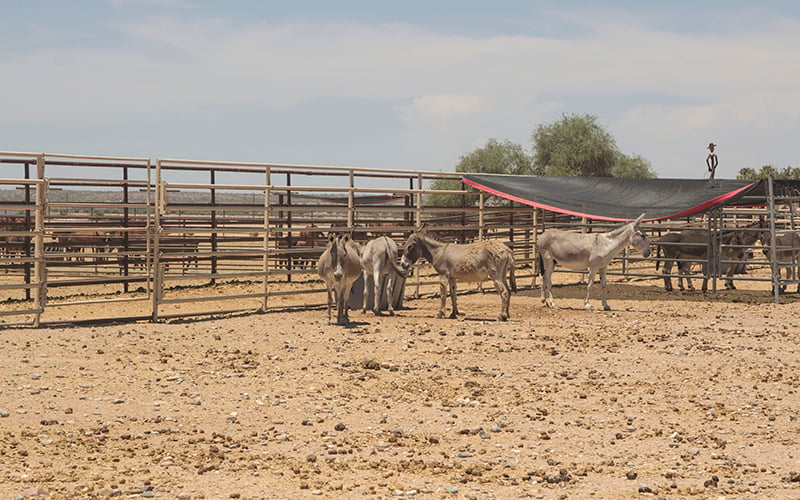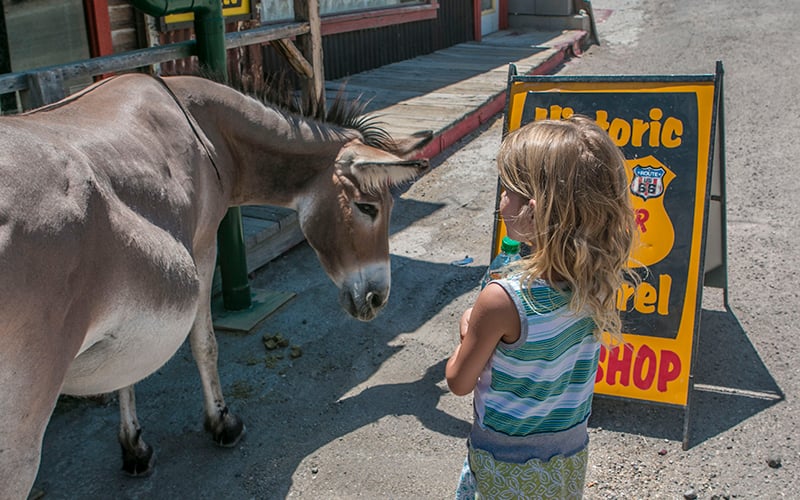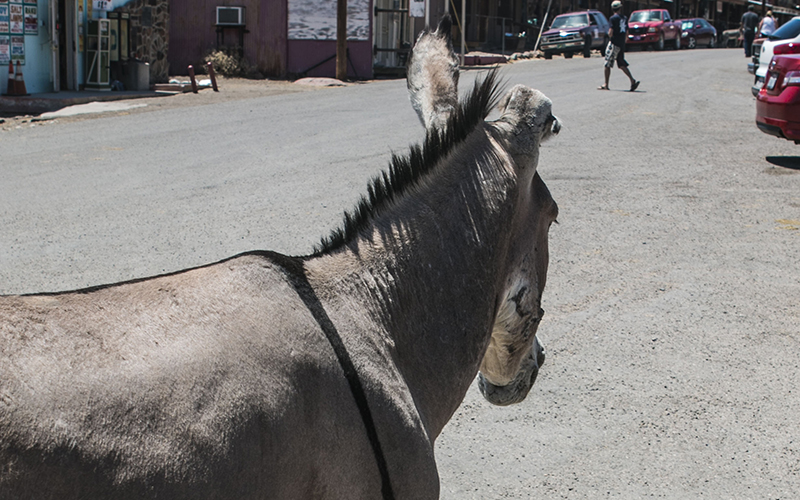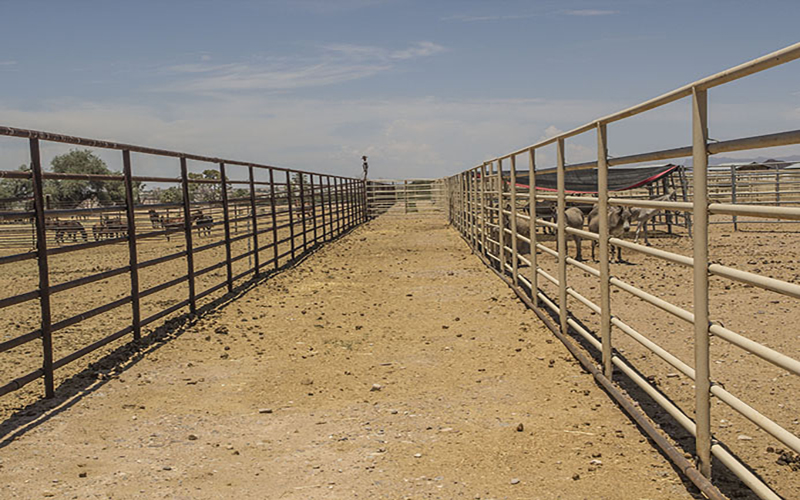- Slug: BC-CNS-Burro Control,1860
- Video of burro begging, interview with burro fan and burro crossing street available.
- Photos available (thumbnails, captions below)
By ISABEL MENZEL
Cronkite News
OATMAN – A wild burro approaches a saloon in the sleepy Arizona town of Oatman, and taps its hooves on the sun-weathered porch. Right on cue, the saloon owner comes out, pats its head and offers it a bite-sized hay cube.
Oatman, with buildings aged by the dusty, hot air and freckled by lonely shops and taverns, is home to burros that are living remnants of a former gold mining town that imported burros to help with the daily burden of labor in the 1860s.
The gold is long gone, but the burros that were no longer needed escaped, or were released to the wild. Their descendants have since turned into a tourist draw for a town where more than 400 burros in nearby Black Mountain outnumber the human population nearly four to one.
But the burros that are an economic boon for Oatman are considered an over-populated nuisance by some in western Arizona.
The Bureau of Land Management houses more than 45,000 wild horses and burros in holding facilities, costing taxpayers $50,000 each, according to the BLM. The BLM estimates that Arizona has more than 5,000 wild burros in the state, more than three times what government officials can manage.
Burros aren’t native to the area and have no natural predators, according to the BLM. They also are highly social, affectionate and trusting, unwittingly endangering people.
“Burros are very opportunistic animals. They will generally trail around roadways, and this is particularly true after rain events: They’ll exploit pooled water and forage for vegetation along these roadways,” said Jayson Barangan, public affairs director for the BLM. “This can pose a public-safety concern, which can be further magnified when travelers see these beautiful animals, stop, take a picture and sometimes even feed them.”
In their quest for food, burros also take the most high-nutrient items for themselves, competing with livestock and native species such as bighorn sheep and ultimately affecting Arizona’s agricultural industry.
In June, federal officials, animal advocacy groups, the U.S. Department of Agriculture and Arizona Congressman Paul Gosar, R-Arizona, were among others who met in Washington to discuss ways to manage public lands, including reducing the burro population.
“Wild burros are creating significant threats to public safety,” Gosar said, according to a video of the meeting posted online by the U.S. House Committee on Natural Resources.
Burros are protected by the Wild Free-Roaming Horses and Burros Act of 1971, passed to stop inhumane population control efforts like the unauthorized hunting and selling of the animals. Federal protection for burros authorizes the BLM to gather or remove excess animals from an area but prohibits them from being killed.
Three prominent methods of population control were discussed at the meeting: the use of temporary fertility vaccines, permanent sterilization, more aggressive adoptions and rounding the animals up and selling them to anyone, which could include “kill buyers” who sell burros for meat.
Simone Netherlands, who manages the Salt River Wild Horse Management Group, an advocacy group to preserve wild horses, scoffs at the BLM’s estimate of what is considered an “appropriate management level.” The BLM estimate for the Black Mountain area is more than 400 burros. “It is a ridiculous number for a million acres,” Netherlands said. “No one is using that land.”
She advocates for birth control or burro adoption. But government officials and animal advocates disagree over those approaches.
Burro birth control
Permanently or temporarily sterilizing female burros, called jennies, can be costly and complicated, government officials said.
The BLM will conduct a pilot program with the national humane society to implement a fertility vaccine known as PZP, or porcine zona pellucida. Adam Eggers, a BLM spokesman, estimated a required environmental assessment would be completed by the fall.
The vaccine is only temporary, typically lasting one to two years. But officials hope effective implementation could reduce costs for rounding up burros and placing them in holding pens.
Barangan, at the Washington meeting, described it as a “trial run.”
Dr. J.J. Goicoechea, Nevada state veterinarian, responded that the effectiveness of PZP is inconsistent. It works on smaller herds of wild horses and burros, but larger herds would need to be permanently sterilized, he said.
Netherlands disagrees. She said permanent sterilization is a terrible option to keep the wild burro bands healthy, because wild burros can’t be offered follow-up care, and sterilization would interfere with a herd’s hormones and dynamic. It would break up herds, she said.
“PZP is suitable for managing all sizes of herds, as long as you have the manpower, and that’s the problem,” said Netherlands, who believes the BLM has not done enough to manage the burro population. “They want more permanent methods which are all very bad for horses, because they don’t have the patience and they don’t want to send the manpower on managing wild burros and horses on the ground. You can’t manage wild horses and burros from an office, you can’t manage them from doing a fly-over once a year. You have to manage them by being in the field and by knowing each and every one of them.”
Netherlands said she has been trying to provide the tools to the BLM and agricultural facilities by offering volunteers to “dart” the burros with PZP vaccine, similar to a Salt River Wild Horse Management Group program that has been successful in managing wild horse populations using that method. She said that if the BLM agrees, the organization will assign volunteers to the specific bands to administer PZP to all animals in a short amount of time. The BLM said working with volunteers is something they need to explore further. Netherlands said using volunteer groups is the best option. Volunteers will keep records on individual burros, ensuring no animals are forgotten or darted twice, and that each mare has an opportunity to contribute DNA to its herd.
“PZP has been used for 30 years on wild horses with no adverse effects,” Netherlands said, adding it is more cost-effective than rounding up burros and keeping them in holding pens. “I don’t care if you’re a forester or a rancher, or someone who is bothered by wild horses, PZP is a solution everyone can agree on because you can control the birth rate.”
The BLM said that the cost of a single dart of PZP is around $30. The Humane Society of the United States said the BLM could save nearly $172 million over the next 10 years by using PZP to manage wild horse and burro populations instead of keeping them in holding facilities.
However, California Congressman Tom McClintock, who chairs the House subcommittee on federal lands, said that the application has been unsuccessful, according to the meeting video.
“Available fertility controls have been largely ineffective at limiting reproduction of wild horses and burros on the range, identifying reliable alternatives has been tenuous, and the administration of existing controls has been met with litigation and resistance from animal rights’ groups,” McClintock said.
Burro adoptions
For years, the BLM has conducted burro adoptions, with thousands of wild burros turned over to owners across the country over more than four decades. But adoptions have been decreasing, which forces the BLM to care for wild burros in holding pens at a high cost to taxpayers.
“Despite dramatic increases in off-range populations and the growing number of animals currently in holding, adoption of wild horses and burros declined steeply in recent years,” McClintock said. “While BLM facilitated the adoption of over 231,000 animals since 1971, over the last 20 years horse adoptions declined by over 73 percent, due mainly to consumer disinterest and other economic factors.”
The BLM is trying to increase adoptions by advertising on billboards in Phoenix. Adoption applications are available through their website and at holding pens. The BLM adopted out 300 burros nationwide last year and 35 from the Florence holding facility, according to Roger Oyler, who works in the BLM’s Florence holding facility.
Eggers said the roundup burros in Arizona are sent to a holding facility in Florence, sharing space with wild horses. From there, prison inmates help train the animals to make them more adoptable, which typically includes getting the animals to be halter-broken and trained to pull a cart. The adoption system is handled in Arizona instead of out-of-state, which means the burros can be adopted more quickly than in previous years and with less stress to the animals.
Netherlands, who has adopted 24 burros that roam her rural Arizona property, thinks that the animals should be available for adoption before they reach a long-term holding facility.
“We think they should be adopted right from the site where they are rounded up because they could get a lot more people to take one, or a band, home,” Netherlands said.
The minimum adoption fee for each wild horse or burro is $125, while jennies with an un-weaned foal are $250. Eggers said potential owners are required to fill out a significant amount of paperwork to make sure the animals go to homes that can properly accommodate them.
“A lot of people don’t even know they can adopt a burro,” said Moss, the Mohave County supervisor. “The general public has no understanding of that. I think if the knowledge was out there, more burros would be adopted.”
Oyler said the ownership title is followed for one year after adoption to make sure burros are not sold to kill buyers. Horses and burros can end up in slaughterhouses in Mexico and Canada when they are sold in auctions without any follow up. In late July, Oyler had only 10 burros left in his holding facility.
Other options
Unrestricted sales of wild burros is another population-control option many are reluctant to make.
Ginger Kathrens, executive director of The Cloud Foundation, a wild-horse advocacy group, said that 80 percent of Americans don’t want wild horses and burros slaughtered.
“I’m here to give voice to the vast majority of Americans who want their wild horses and burros to roam freely on their home ranges, a fact supported by national opinion polls,” Kathrens said at the Washington, D.C. meeting.
Keith Norris of the Wildlife Society, a nonprofit group to promote wildlife stewardship through education, countered that the BLM should lift its restriction on sales, even if burros end up with potential kill buyers.
“The option that exists is finding ways to get horses out of those holding facilities,” Norris said. “There are a couple ways of doing this – adoptions, transfers – but neither of these are going to reach the level that we need to. So that leaves us with unrestricted sales…something that I think this committee should consider,” Norris said.
Another approach focuses on moving wild horses and burros away from populated areas in Arizona. The BLM approved a research project proposed by the Arizona Game and Fish department and the Arizona Department of Transportation to evaluate the movements of burros and collisions near Lake Pleasant area, perhaps by placing GPS collars on the animals. Also, ADOT and a national wild horse and burro program financed a combined $150,000 for more fencing along Arizona interstates and freeways, mostly along I-17.
Netherlands suggests using diversionary feeding or water sources to get burros away from problem areas.
“They will go to where they can find water and food,” Netherlands said. “It’s very easy to move them.”
^__=
Girl approaches wild burro with curiosity in Oatman, AZ. (Photo by Isabel Menzel/Cronkite News)
 Oatman relies on burros for tourism. (Photo by Isabel Menzel/Cronkite News)[/caption]
Oatman relies on burros for tourism. (Photo by Isabel Menzel/Cronkite News)[/caption]

Burros in BLM holding pens in Florence. (Photo by Isabel Menzel/Cronkite News)
Burro crossing road in Oatman. (Photo by Isabel Menzel/Cronkite News)
Black Mountain area near Kingman, AZ. (Photo by Isabel Menzel/Cronkite News)
Burros on right and horses on left in BLM holding pens. (Photo by Isabel Menzel/Cronkite News)
A recently rounded up jennie feeds her young foal in a BLM holding pen. (Photo by Isabel Menzel/Cronkite News)




